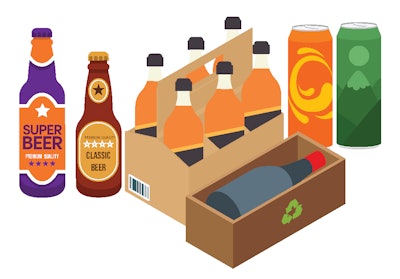Success in craft beer and spirits can come in many shapes and sizes, and as producers are learning in the current craft market, so can their packaging.
That’s according to PMMI Business Intelligence’s “2024 Craft Beer and Spirits: Success Through Packaging” report. To overcome a challenging marketplace, craft producers are turning to a variety of packaging strategies, to help their products stand out and build a loyal customer following.
More than anything else, the maturity and density of the craft market are pushing craft producers to stake out unique and memorable brand identities designed to build a loyal base of repeat customers. Rather than chase consumer-driven style and flavor fads, craft producers are looking inward to capitalize on their own unique identity that best supports their strengths and brand goals.
The most important tool for craft producers in establishing this identity is packaging. Packaging features such as premiumization and sustainability make products stand out on the shelf and speak directly to the concerns of customers, while providing a variety of packaging formats and sizes caters to convenience and consumer lifestyles.
A world of variety in the craft market
With so many brands and products to choose from, craft consumers have more options available to them than ever before.
Because of this, craft consumers have also become accustomed to a huge variety of choices when it comes to format: from single-serve sizes to mixed 12 packs, craft consumers expect to find exactly what they want in precisely the packaging format they want it in.
The inclusion of packaging variety – from size to format – has become a necessity for craft producers looking to build a comprehensive brand identity.
When it comes to meeting consumer demand and building a brand image, craft producers should focus on three main variety-based strategies: primary packaging size, multipacks, and specialty releases.
Primary packaging size variety
Convenience and active lifestyles have endured as dominant consumer trends post-COVID, and craft beer and spirits are no exception.
For craft producers, this means their customers are looking for more size options and more format diversity to fit craft offerings seamlessly into their routines. To address this desire for size options, craft producers should carefully consider primary packaging variety on a product-by-product basis.
From a machine standpoint, this translates into a need for adaptable equipment.
While complete adaptability like filling bottles on a canning line is functionally impossible, OEMs and suppliers should carefully consider how versatile they can make their machines within a format.
Multipacks and variety packs
Multipack formats, including multipacks that have a mixed variety of different products in them, have remained a popular SKU option over the last decade of craft industry adjustments.
Consumers consistently report liking these formats because they align with numerous consumer trends such as new experiences and a plethora of choices. That said, they are notoriously challenging for craft producers to accommodate, creating operational headaches.
To assist craft producers, OEMs and suppliers can draw on their past experiences with the format to help advise their current customers as they evaluate mix-pack options.
OEMs and suppliers should remain candid during this process, especially when they feel a move to variety packs or multipacks does not make business sense for a customer. Not all craft operations can or should accommodate this format.
Specialty or one-off releases
Another important consideration in product variety is the inclusion of specialty and one-off releases.
Rare and limited batches, seasonal offerings, one-off collaborations, and rotating unique iterations within a themed line have all become standard practice within the craft industry.
While these offerings are a great way to connect with consumers and build a brand, they can also create significant production challenges for craft operations. Specialty offerings almost always include unique labeling, often include variations in package size or shape, and might tack on extras like a decorative secondary package.
To mitigate downtime when specialty runs must be accommodated, OEMs and suppliers should work to expand the level of process automation on their equipment or assist their craft customers in making machine alterations or additions to support increased automation.
SOURCE: PMMI Business Intelligence – 2024 Craft Beer and Spirits: Success Through Packaging
For more insights from PMMI’s Business Intelligence team, find reports including “2023 Sustainability and Technology – The Future of Packaging and Processing” and “2023 Building an Effective Talent Strategy for the Packaging Industry” at pmmi.org/business-intelligence.
Download the FREE report below.



























